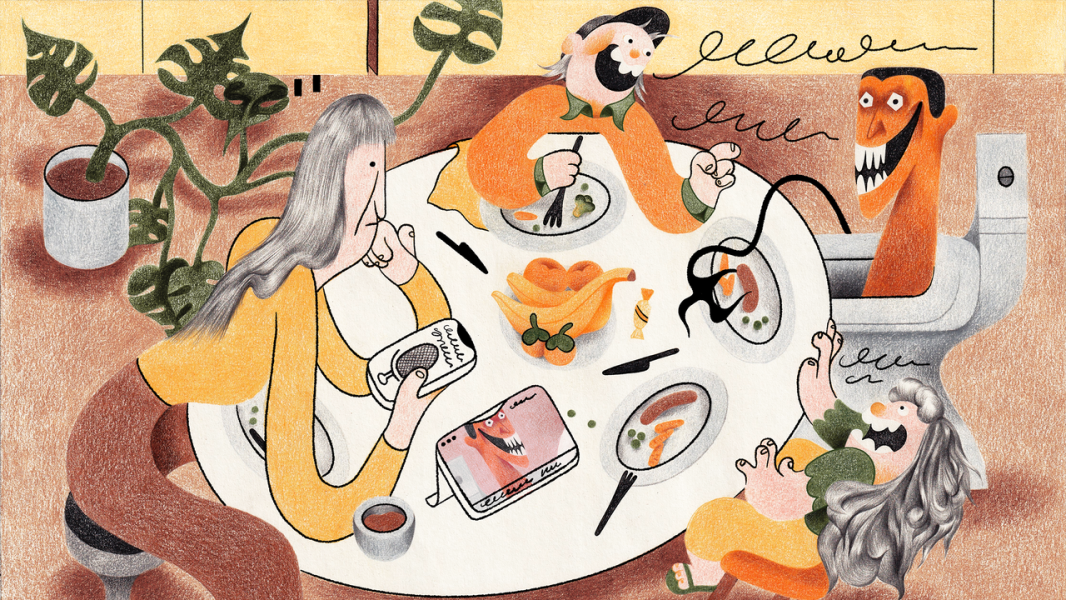
Save this storySave this storySave this storySave this story
Even as late as November, across the sports fields of our little New England town, you could still hear the call, as if from sparrows chatting in the branches of a depleted maple tree. “Skibidi, skibidi, skibidi,” a boy, maybe seven, sang to himself, as he dribbled a soccer ball toward his last practice of the season. On the sidelines of a field-hockey game, another kid, ten or so, admonished his younger brother, “What the skibidi are you doing?” Just before Thanksgiving, when the fifth graders were exchanging notes of gratitude at school, one wrote to another, admiringly, “You are so skibidi sigma.”
High season for “skibidi” was the spring. It wafted up from Little League dugouts and from gaga pits; it drew chemtrails across trampoline parks. (At afternoon dismissal, one girl in our orbit would, if the spirit moved her, raise her face to the sky and keen, “Skibidi!”) The word, as a floating signifier, stood apart from other omnipresent specimens of Gen Alpha lingo: “aura,” which quantifies a person’s cool factor and may or may not correlate with their rizz; “Ohio,” which means weird in a bad way; “sigma,” which bubbled up from incel culture, and which denotes either a cool loner or a unit of surprise, as in, “What the sigma?” (“It’s a Greek saying,” my son clarified.)
2024 in Review
New Yorker writers reflect on the year’s highs and lows.

But “skibidi” has no fixed meaning or syntactic function—or, at least, none that a person born in the twentieth century could readily pinpoint. “Skibidi” could be an adjective, an interjection, an exclamation, a perseveration. If you know, you know. What is skibidi? I asked a third grader recently. “It’s a meme,” he replied. And what is a meme? “It’s something cool you find online.”
The semiotics of “skibidi” are somewhat more legible in its original context. “Skibidi Toilet,” an insanely popular series of YouTube shorts by the Georgian animator Alexey Gerasimov, depicts a war between, on one side, toilets with human heads protruding from their bowls and, on the other, humanoids who have speakers, screens, or surveillance cameras for heads. The earliest episodes, which débuted last year, unfold to a techno mashup of Timbaland’s No. 1 hit “Give It to Me” and a Bulgarian folk-pop tune, featuring an earworm of scat syllables that can be rendered phonetically as “Brrrr skibidi dop dop dobby yes yes, skibidi dopple dop, neet, neet.”
The demographic appeal of “Skibidi Toilet” is axiomatic. Toilets are funny, a weird head poking out of a toilet is even funnier, and a weird head poking out of a toilet singing jibberish and annoying nearby adults is the funniest. (The podcaster Alex Nichols captured these truths in a tweet set to the tune of “Drift Away”: “Skibidi toilet and free my soul / I want to see a head in a toilet bowl / cause I am 8.”) The toilet men, who have the grooming and rictus of a coke dealer loitering in the alley behind Tbilisi’s seediest dance club, appear to be members of a terrorist group or paramilitary organization; it’s plausible that the speakermen and cameramen whom they fight are the soldiers of a totalitarian surveillance state. “Skibidi dop dop dobby yes yes” is the battle cry of the scummy underdog, and there is not a toilet brush and bleaching agent strong enough to scrub it from my brain.
My kids and their friends use the term “brain rot” to describe both “Skibidi Toilet” and the lexicon of slang that “skibidi” exemplifies. Oxford University Press, which named “brain rot” its Word of the Year, described it as “referring to low-quality, low-value content found on social media and the internet, as well as the subsequent negative impact that consuming this type of content is perceived to have on an individual or society.” Brain rot is thus a strikingly capacious term, enfolding the psychological and cognitive decay wrought by screen addiction, the bacteria-like content that feeds the addiction, and the argot of a generation for whom much of this content is made. When I asked my son, who is seven, to define “brain rot,” he replied, “Skibidi Ohio rizzler.”
The word “skibidi” entered my household around March, when my son, who had been returning from school every day with tales of Pokémon, started coming home bearing news of “Skibidi Toilet.” A couple of his first-grade classmates had seen Gerasimov’s YouTube shorts, which, to date, have been viewed tens of billions of times. More kids seem to have had their first “Skibidi” encounters on Roblox, the world-building gaming platform. For still others, “Skibidi Toilet” was something like an epic poem passed down in the oral tradition—anybody could know the song and the basic premise just from playground word-of-mouth.
From the start, Gerasimov has created “Skibidi Toilet” using Source Filmmaker, free animation software by the video-game company Valve. (The leader of the toilets is a dead ringer for the G-Man, a character from Valve’s “Half-Life” series.) Older viewers will associate the visuals with the sandbox game Garry’s Mod, which helped to define the janky, neo-Surrealist landscape of late-two-thousands Internet culture. (That aesthetic has now migrated to “Skibidi” merch—action figures, plush toys, Halloween costumes, and a Mystery Surprise Toilet, which has a spring-loaded head and makes a flushing sound.) In Gerasimov’s first, super-concise conjurings of the Skibidi universe, his merry band of nihilists typically slide around on their grimy porcelain bottoms, bugging their eyes and thrusting their necks, until they either get flushed by a speakerman or they lethally attack whichever cameraman is filming the action. These jump scares provide the endings to several exceedingly brief “episodes”; the first “season” of “Skibidi Toilet” is, in its entirety, one minute and six seconds long.
The series of today bears little resemblance to its early incarnations. You don’t hear the song much anymore, for one. The seventy-seventh and latest installment, which dropped on November 19th, is the length of a network sitcom and depicts an apocalyptic global war. In Khabarovsk, in Russia’s Far East, a cameraman-soldier in a tracksuit takes a last swig from a bottle of vodka before heading into a firefight. In a reddened moonscape of Denver, a giant toilet lies toppled, like Lady Liberty at the end of “Planet of the Apes.” Menacing heads protrude from giant hovering drone crafts or tanks, which can sometimes unfurl their components to reveal the toilet within, much like a Transformer. This is apt, as Michael Bay, braintrust of the “Transformers” movie franchise, is reportedly developing a “Skibidi” film adaptation. The trajectory of “Skibidi Toilet”—from goofy, unsettling lark to ultraviolent defense-contractor infomercial—is similar to that of Chris Pratt, who rose to fame as an oaf who falls into a pit on “Parks and Recreation” and now plays Green Berets on HGH in movies with names like “Killshot Creed 3” and “AssassinNation: Classified.”
Episode 77 racked up nineteen million views in its first week on YouTube, but I don’t get the impression that many of them came from our cohort. “Kids aren’t watching all that,” my ten-year-old daughter said, a bit disdainfully. If “Skibidi Toilet” is quintessential brain rot, then at least the kids are choosing the lesser of two bacteria. At least they prefer toilets and nonsense over conscription into the military-industrial-entertainment complex.
Recently, I fumbled explaining the “brain rot” concept to a friend whose children are the same age as mine, and I was touched by how he hastened to come to the kids’ defense—our parents denigrated what we enjoyed, too, he said, and we shouldn’t repeat that mistake. I agree with him. But “brain rot” is a word that the kids seem happy with. This is their slime era, and it conjures something that’s runny, oozy, squishy-squelchy; it’s as funny and gross as the Garbage Pail Kids, or a head in a toilet bowl. “Brain rot” also hints that they recognize how much time they spend online, and they understand, to some extent, that a lot of what they watch—like a lot of what we watched—is suboptimal. (My daughter has said as much to me, although she was likely pandering to her audience.)
But they’re not looking for a way out, at least not yet. The digital spirochetes in their brains are like additives in the food, fluorochemicals in the water, particulate matter in the air—one still must eat and drink and breathe. This is a hard world we’ve given them. It’s mean and stupid, run by surveillance agents and toilet men. It’s getting warmer, dirtier, and uglier every day. The kids have no choice but to take what they can from all that’s rotting around them. ♦
Sourse: newyorker.com






